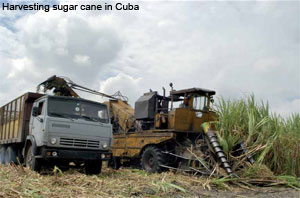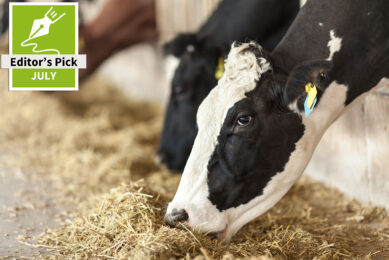Vinasse in feed: Good for animal and environment

Vinasse, a by-product of ethanol production from sugar cane, is abundantly available in Cuba. Its nutritional value can be used as anadditive to animal feed. At the Institute of Animal Science in Cuba trials have shown that (concentrated) vinasse has several functional properties in improving animal performance.
The word vinasse is derived from the Latin word vinacaeus, originally known as yeast wine. Its use, reported in several tropical countries and in Europe, is as an additive or feeding supplement for the feeding of ruminants and non-ruminants. Additionally it has been used as a fertiliser since the beginning of the 20th century. Vinasse is the main effluent of ethanol production coming from sugar cane. It has a 93% water and 7% solid compound, with a low to high dark colour, bad odour, acid pH, high temperature and high levels of salt (among 24,000 to 80,000 mg/l) and organic material (4,000 a 64,000 mg/l). This effluent has also high concentrations of potassium, calcium, magnesium, sulphur and nitrogen. For every litre of ethanol produced between 12-20 litres of vinasse is produced. One of the aspects limiting its use in animal feeding, is the low content of dry matter, apart from the pH values that can cause corrosion in storing and distribution tanks. However, the pH values favour the presence of the saprophyte intestinal flora and prevent the diarrhoeal processes.
Nutritive value
The nutritive value of vinasse varies depending on the alcohol production process, the raw material used, climatic conditions, and soils and technology used, which does not allow giving rigid values to each indicator (Table 1). The low values of fibre may be represented almost totally by the glucans and mannans present in the walls of the yeast used in the process.
The distillery vinasse is a low energy feed, as the sugars present in the molasses are used for the alcohol production. The amino acid profile of vinasse allows us to assume that they contribute to the intermediate metabolism of the different species, as well as the activation of the immunological system (Table 2). The mineral contribution is suitable for animal production, highlighting iron, calcium and phosphorous. In general about two thirds of phosphorous offered by plants are part of the phytic acid as inositol phosphate. These forms are not widely available for non-ruminants as they do not have the phytase enzyme to hydrolyse the phytic acid into inositol and orthophosphate. In this case, the phosphorous offered by vinasse can be almost totally available as it comes from the yeast used in the fermentation. In regards to calcium, this is very important for the formation of bones and teeth, blood coagulation and nerve transmission.
Another aspect giving importance to vinasse is the content of organic acids. Similarly is the contribution of vitamin B-complex present in all vinasses. Treatment with ammonium sulphate lowers the potassium level and increases the sales of the product.
Benefits in animal dietsVinasse has been used as a liquid in animal feeding, alternatively it can be used dried which makes it easier to distribute and improves intake. It has been used as an additive in different species for its probiotic properties, in non-ruminants 1-3 % is added to the formula and in ruminants 4-5%, either as a carrier in premixes, a palatability improver, ruminal activator, or promoter of sexual maturity and reproduction. The use of vinasse as an additive generally incites a better feed conversion, and an increase in live weight and growth due to the presence of organic acids. These organic acids support a better use of nutrients, improve digestion, synthesis and vitamin and mineral adsorption, thus facilitating feed metabolism. Vinasse also keeps the intestinal flora in balance thus avoiding the propagation intestinal pathogens, as any threat to the gastrointestinal health negatively influences total productivity.
Vinasse in ruminant diets
In calves, vinasse is used as a supplier of molasses in a ration 1:1 in integral diets with a maximum inclusion of 5 %. It is recommended to consume the feed within 72 hours. In heifers fed on pastures and forages, an intake of 2 litres/animal/day results in a reported daily increase of 100 g growth compared to heifers not receiving the product. An increase of 6 % in gestation effectiveness was observed. In dairy cows, where star grass, forage CT-115 (clone ofPennisetum purpureum) and Norgold potatoes were used as basis feed, the intake was 2.7 litres/cow/day and in dry cows 1.3 litres/cow/day. With this intake level, an increase of 2 litres of milk per cow was achieved without affecting the quality of the milk. In growing and adult ruminants no performance and health problems have been observed, although the intake is unstable. Intake depends on the basis feed, if the product is mixed with forages the intake increases.
Use in birds
In broilers, the inclusion rate is 14 ml/animal/day on average in the whole growing period and it is sprinkled on the feed in the morning and afternoon. The results indicate a similar intake of feeds with an extra gain of 200 g in live weight and a better feed conversion, indicating a better efficiency use of the nutrients in the diet. Broilers fed vinasse showed a 2% improvement in liveability and an increase in weight of the edible pieces (carcass: 155 g superior, breast: 46 g, leg + thigh: 10 g), and no increase in weight of viscera and abdominal fat. In the rearing period of layers, it is used from day one at a rate of 14 ml/bird/day (after 35 days). The results show a better uniformity, reporting an average weight increase of 67g (1386 g at 18 weeks of age) compared to a control flock.
The development of the reproductive organs from 16 weeks of age onwards is better with a higher deposition of abdominal fat, allowing the birds to have reserves for egg production. It was reported that birds start laying at 17 weeks of age (instead of 20 weeks) and produce 16% more eggs when consuming vinasse. Mortality of the birds is one of the most important aspects when using vinasse. A mortality decrease of 11 % is reported, evidencing a beneficial health effect. In laying hens, the supply of 2-3% (15 ml) in the diet increases egg production and laying intensity up to 5 %. Feed conversion is improved with 12 g less feed per egg produced and mortality was 3.3% lower.
Better health of pigs
Young animals benefit the most from vinasse addition to the feed, since their immunological system has not yet fully developed. In suckling piglets (1 to 33 days of age), vinasse may be offered successfully in two ways: 5 ml of vinasse/piglet at the third day of age orally in one dosage or 1% of vinasse in the feeds daily from 14 days of age. A gain increase of 32 g per day was achieved resulting in a 1.02 kg increase in live weight at weaning. Another aspect reported was the improved uniformity of the litter weight that is higher than 85%.
In growing pigs (33 to 89 days of age), 10 ml of vinasse/animal/day may be offered mixed with the daily ration during the first three weeks.
With this inclusion level, the live weight increased with 4.4 kg, mortality is reduced with more than 20% and incidence of diarrhoea is reduced by 26%. In pig fattening, an intake of 0.5 kg/animal/day is achieved in pigs from 20 to 50 kg when it is supplied over the traditional feeds. In the stage from 50 to 100 kg of live weight, the maximum intake of vinasse is 1 kg/animal/day. Pregnant sows consume up to 1 kg of vinasse/day, giving to the sow 32.28 g of crude protein, 1.34 g of calcium, 0.5 g of phosphorous and 185 g of iron, apart from the not -quantified amounts of hydro-soluble vitamins, minerals and walls of yeasts with shown probiotic effects.
New feeds
Another aspect that is being researched at the Institute of Animal Science is the production of new feeds for cattle from silage and distillery vinasse. The pH value of the vinasse guarantees that a new feed (cassava silage + vinasse + protein-mineral-vitamin supplement) does not deteriorate during several months. The average intake is 7 kg/animal/day and the final weights are similar to when feeding traditional diets.
Another innovation has been the production of compound meals. This idea derives from the Cuban experience of sun drying liquid feeds with fibrous support of the nutritive value of sugar cane, wheat bran or other products, which has been common practice for many years. This alternative consists of a combination of wheat bran (40%), vinasse (40%) and cassava meal (20%), which requires only 24 hours of sun drying.
Another benefit of using distillery vinasse is the reduction of environmental pollution, as it is considered the greatest polluter from sugar cane processing.











